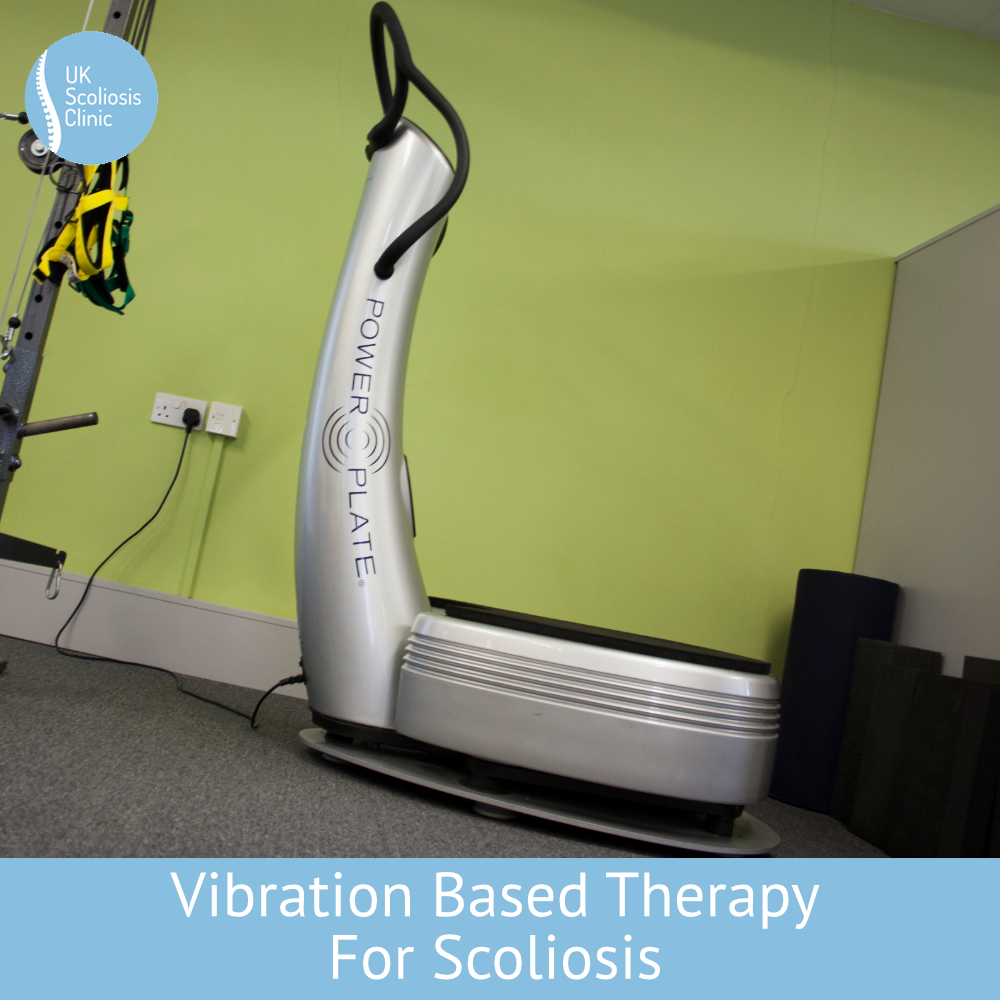
Scoliosis researchers are nothing if not creative, and today we’re looking at a lesser-known, but interesting additional approach published in 2017.
In the field of physiotherapy in general, there has recently been a trend to incorporate vibration platforms into routines designed both for prevention and rehabilitation. Whole-body vibration (WBV) is a reflex-based neuromuscular form of training, and Side-alternating WBV (sWBV) is a special form of WBV which uses a “side to side” type of motion. It’s already known that this kind of vibration platform can be of use of physiotherapy, with studies reporting increased muscle force and power as well as effects on neural activity.[1][2][3]
The study authors point out that vibration-assisted exercises have the advantage of short training periods with a high number of muscular contractions/ repetitions, while the increasing availability of these kinds of vibration platforms make a home training program a real possibility. A home program also has the advantage of possible better compliance compared to frequent visits for supervised therapy programs. With these benefits in mind, this study sought to investigate the possibility of incorporating vibration therapy with Schroth based exercise and bracing for Scoliosis patients.
Study details
The study[4] was a randomised controlled trial, with assessments performed at month 0 and moth 6. The participants were randomly assigned to either a scoliosis specific exercise program on a vibrating platform or “treatment as usual” – here, normal Schroth exercise.
40 participants were recruited through the Paediatric Rehabilitation Centre, UniReha GmbH, University of Cologne, Germany in collaboration with the Department of Orthopaedic and Trauma Surgery, University of Cologne, Germany. Included were girls with moderate AIS (according to the SOSORT criteria) aged 10 to 17 years. Further inclusion criteria were: experience with auto-corrective physiotherapy (specifically Schroth) and use of a Chêneau brace at least 16 hours per day.
Participants of the intervention group received an introduction to the sWBV system and the exercises before the start of the home-training program. They received an exercise program including four different exercises: standing (16-20 Hz), sitting (18-25 Hz) and two different kneeling positions (10-20 Hz). Exercises were designed to incorporate auto-correction and stabilising physiotherapy. Each exercise was performed at home for three minutes (4×3 minutes) five times per week.
Each participant received an exercise folder containing photos of the exercises and individual adaptations according to the severity of curvature and a training schedule. Each participant documented the home-training program in a training log. For six weeks the participants received a weekly in-patient check; then the check-up frequency was reduced to bi-weekly. Serious unexpected events were recorded at each visit.
The participants of the control group were instructed to continue with their usual auto-corrective physiotherapy. This usually contains bi-weekly training under the supervision of a physical therapist and a daily home-training program. Schroth exercises focus on strengthening of the spinal musculature and elongating shortened muscles on the concave side of the spinal curvature.
Results
The results from the study were certainly positive – and suggest that further research and experimentation with this method may well be worth considering. The major scoliosis curve in the sWBV group decreased significantly by -2.3°, compared to the difference in the control group of 0.3°. In the sWBV group 20% (n=4) improved, 75% (n=15) stabilized and 5% (n=1) deteriorated by ≥5°. In the control group 0% (n=0) improved, 89% (n=16) stabilized and 11% (n=2) deteriorated. The authors also observed that the clinically largest change was observed in the ‘before menarche’ sub-group.
While it’s important always to remember that a single study is not enough evidence to make a firm conclusion, this line of research is of great interest to us at the UK Scoliosis clinic, since we already utilise vibration-based therapy in treating other (non-scoliosis) conditions, and have observed results (in terms of speed of outcome) which are broadly consistent with these findings. We’ll be keeping this option under close review!
[1] Matute-Llorente A, Gonzalez-Aguero A, Gomez-Cabello A, Vicente-Rodriguez G, Casajus Mallen JA. Effect of whole-body vibration therapy on health-related physical fitness in children and adolescents with disabilities: A systematic review. J Adolesc Health. 2014;54:385–96.
[2] Cochrane DJ. The potential neural mechanisms of acute indirect vibration. J Sports Sci Med. 2011;10:19–30.
[3] Rittweger J, Mutschelknauss M, Felsenberg D. Acute changes in neuromuscular excitability after exhaustive whole body vibration exercise as compared to exhaustion by squatting exercise. Clin Physiol Funct Imaging. 2003;23:81–6.
[4] Sina Langensiepen et al. Home-based vibration assisted exercise as a new treatment option for scoliosis – A randomised controlled trial J Musculoskelet Neuronal Interact. 2017 Dec; 17(4): 259–267.


